Introduction
The COVID-19 pandemic has caused many sectors of the society to change their way of functioning. One of the prominent areas in this case was education in general, and higher education in particular. Universities were faced with the need to immediately convert the teaching mode to distance learning. Thanks to the existence of distance learning platforms such as Zoom and MS Teams (Ismaili, 2021), this task has become possible to implement in an efficient and effective way. There are numerous research works concerning the students’ experience during the pandemic that investigate various aspects of this topic, including factors influencing positive student attitude towards online learning (Afroz et al., 2021), student preferences concerning online education (Muthuprasad et al., 2021), and the pandemic’s influence on mental health and general wellbeing (Rippe et al., 2021; Steward and Lowenthal, 2021; Liu et al., 2021). However, to the best of our knowledge, an investigation of changes in behavioral patterns of online activities, including online learning, has not been conducted in a comprehensive way. We would like to fill this gap by answering the following research question:
RQ: Have the students’ online behavioral patterns changed as a result of the pandemic, and how?
In order to answer the research question, we conducted a survey among students of the Cracow University of Economics, Poland. The paper is organized as follows. The next section presents the research background. Then, the research method is described, followed by a presentation of the research outcomes. The main research results are summarized in the Implications and Conclusion sections.
Research Background
Zoom and MS Teams platforms have faced an unprecedented increase in popularity during the pandemic, and while they offered some of their services free of charge (such as Zoom), they saw massive revenue growth. For example, Zoom generated $2.6 billion in revenues in 2020, representing a 317% year-on-year increase, and the number of users increased from 10 million in 2019 to 350 million in December 2020. More than 90,000 schools were using this software at the height of the pandemic (Iqbal, 2021). In turn, MS Teams increased its user base by 95 million in 2020, which placed it as the fastest-growing application during the pandemic. It was used by over 500,000 organizations and generated $6.8 billion in revenues in 2020, a 700 percent increase year on year (Curry, 2021).
According to Muthuprasad et al., (2021), 70 % of students are ready to participate in online classes and manage their curriculum. A similar conclusion was formulated by Händel et al (2020). Afroz et al., (2021) have analyzed attitudes towards online e-learning during COVID-19 in Bangladesh. They found out that the cost and time effectiveness, safety, convenience and improved participation constitute positive elements of the online experience, whereas distraction, reduced focus, heavy workload, technological problems, lack of ICT skills, and low attendance of learners are among the negative elements. Online education is a complex phenomenon. It includes participation in online classes, online discussions, contacting classmates during project implementation, maintaining private contacts, and interacting with social sites, which corresponds with the social dimension of students’ activity.
An interesting problem related to distance learning is the behavior of students in this context and the impact of distance learning on their mental condition, defined as wellbeing. It is also interesting if they constitute a uniform structure, or if we can find different segments of students. Händel et al. (2020) when analyzing prior experience with e-learning, and skills for digital learning indicates that students constitute two clusters, considering technology availability. These groups differ significantly according to their emotional characteristics such as stress related emotions like worries, tension, joy, task overload, and emotional loneliness. Emotional loneliness and isolation of students were destructive factors even before the pandemic, but during the pandemic, due to the closures of campuses, they got intensified (Rippe et al., 2021; Steward and Lowenthal, 2021). This intensification leads to more severe consequences. According to Herbert et al., (2021), almost 52% of online learners indicated depressive symptoms. Existence of problems among the online learners such as stress, anxiety, depressive symptoms, self-reported worry, grief, generalized anxiety and post-traumatic stress disorder symptoms, was also indicated by various studies (Conrad et al., 2021; Lee et al. 2021; Lischer et al., 2021). The remedies for the above might be physical activity (Coyle et al. 2020) and providing students with the resources by universities to improve their self-regulation and time-management skills (Keyserlingk et al., 2022). In Liu et al., (2021), the model of students’ psychological wellbeing has been defined. The authors have distinguished six negative predictors, i.e., white/European ethnicity, restriction stress, perceived worry on mental health, dietary changes, perceived sufficiency of distancing communication, and social isolation. On the other hand, physical health status, emotional support, and resilience constitute positive predictors of psychological wellbeing. Other variables, like age, gender, international status and educational level did not have any predicting power.
Research Method
The current research is part of a joint research project undertaken by the faculty of Cracow University of Economics, Poland, and Zhytomyr Polytechnic State University, Ukraine. The team from Cracow University of Economics has developed the survey, the general goal of which was to gather students’ feedback related to their learning experience during the pandemic. A number of academics from Cracow University of Economics has revised the preliminary version of the survey, and then about dozen students checked the understandability and clarity of the questionnaire items. This has led to the final version of the questionnaire. The questionnaire items relevant to the current research are presented in the Annex.
The survey was implemented using the Microsoft Office 365 form tool. The link to the survey was sent to all students (bachelor, master, PhD) of Cracow University of Economics using the standard mailing list. Students could access the survey without the necessity to login to their Office 365 account. The link was available in May and June of 2021. The estimated number of students who received the invitation to take part in the survey was 14 000. As the number of returned questionnaires was 1005, the response rate of our research reached 7%. Based on the modified Cochran Formula, such a response means that the margin of error is equal to 3% with a confidence level of 95%. The data were analyzed using descriptive and inferential statistics.
The respondents’ main characteristics are presented in Table 1. For the purpose of further investigation, we divided students into three categories based on their previous experience with a higher education traditional form of learning. However, the essence of the division is not only the question of the experience in distance learning, but rather the experience in face-to-face contact with classmates in a higher education setting. The categories have the following characteristics:
- Low – students who have not experienced higher education teaching in a traditional form (first year students of bachelor studies); they did not have the opportunity to meet classmates face-to-face,
- Medium – students who have had an about half-year experience in traditional higher education (second year students of bachelor studies),
- High – students who have had at least one and half year experience (third year students of bachelor studies, students of master studies and PhD students); they had a long-lasting face-to-face opportunity to interact with classmates.
Table 1: Respondents’ structure
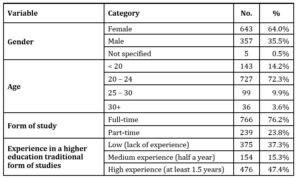
Respondents’ general IT skills distributed across gender and their experience with a higher education traditional form of studies are presented in Table 2, whereas their technical conditions are presented in Table 3. About 97% of the respondents indicated their general IT skills as being average or above, and their technical conditions as being sufficient for basic needs, facing only occasional problems.
Table 2: Respondents’ general IT skills
Table 3: Respondents’ technical conditions
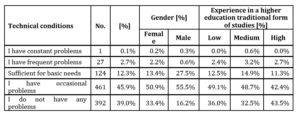
We investigated the number of respondents’ friends before and during the pandemic. “Friends” in this context we define as people with whom respondents actively maintain contact in the private sphere, e.g., colleagues from the student group are not friends, as long as they do not keep in touch with them, we do not treat occasional comments on Instagram as contact.
We evaluated the changes in wellbeing on the following scale, on the basis of the answers to question 16 from the survey (see Annex):
- worse (wellbeing significantly deteriorated or worsened),
- without change (no change in wellbeing),
- better (wellbeing improved or significantly improved).
Results
The bigger picture – wellbeing
In order to investigate more deeply the bigger picture of changes in online activities and their possible causes, we first had a look at the respondents’ perceived changes in their wellbeing (see Figure 1). More than half of the women noticed deterioration in their wellbeing, whereas a similar observation was made on less than 45 percent of men. Interestingly, almost 10 percent more males than females reported unchanged wellbeing.
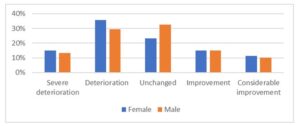
Fig 1. Respondents’ perceived wellbeing changes in relation to gender
It should be noted that severe deterioration was noticed by the respondents with a medium experience in the traditional form of learning; almost 60% of respondents in this group reported deterioration (Figure 2). Interestingly, for most of the respondents with a high experience in the traditional forms of learning (56%), the wellbeing remained unchanged or has improved.
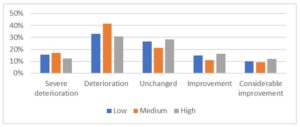
Fig 2. Respondents’ perceived wellbeing changes in relation to their experience with traditional university teaching
Changes in online activity patterns
An increase in the number of hours spent online, and numbers of hours online related to learning, is clearly visible (Figure 3 and Figure 4 respectively). There were not any considerable differences between females and males in this regard. The highest shift in the number of hours spent online is visible in the Medium respondents’ group.
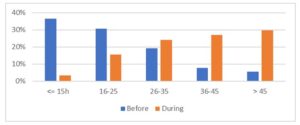
Figure 3. Distribution of respondents by the number of hours spent online per week
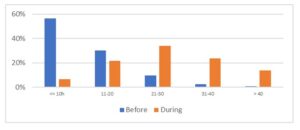
Fig 4. Distribution of respondents by the number of hours online related to study
However, when comparing the estimated (on the bases of the middle of intervals/bands) average numbers of hours spent online and of activities online related to studies, we observed that the highest change in both aspects reported respondents who had medium experience with traditional learning. The difference among males and females is also visible, with women reporting a higher increase (Table 4).
Table 4: Estimated average numbers of hours of activities online and activities online related to studies before and during the pandemic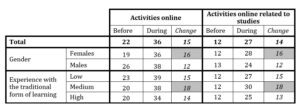
The percentage of online activities connected with learning has increased considerably in all subgroups, however in the group of respondents with low experience in the traditional form of learning, the increase was the most noticeable (Table 5). Respondents with a long experience with traditional learning noticed the lowest increase in activities online related to learning.
Table 5: The percentage of online learning in total online activities
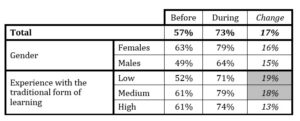
Interestingly, the increase in total online activities during the pandemic might be explained by an increase in online activities connected with studies only in the Low and High categories of respondents.
The distribution of the number of friends online is presented in Figure 5. A decrease in the number of friends online is visible.
The distribution of the number of face-to-face friends is presented in Figure 6. A considerable decrease in the number of face-to-face friends is noticeable, regardless of gender, with more than half of the respondents declaring less than six friends face-to-face during the pandemic, whereas only about 20% declared this number of friends before the pandemic.
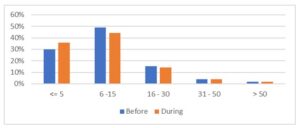
Fig 5. Distribution of respondents by the number of contacts online
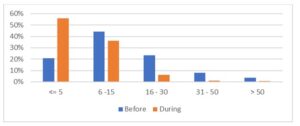
Fig 6. Distribution of respondents by the number of face-to-face friends
Table 6 presents the estimated (on the bases of the middle of intervals/bands) average numbers of friends online and face-to-face.
Table 6: Estimated average numbers of friends before and during the pandemic
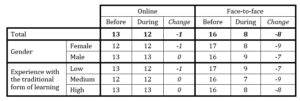
The preferable way of spending time is depicted in Figure 7. The percentage of respondents spending their time alone or in small groups has increased.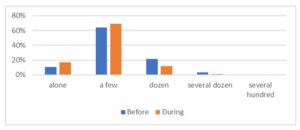
Fig 7. Preferable size of groups for social activities
The changes in the frequency of online contacts are depicted in Figure 8.
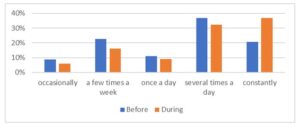
Fig 8. Frequency of online contacts
The global changes in the attitude towards online communication and attitudes towards distance learning are illustrated in Figure 9.
- Communication online b) Distance learning
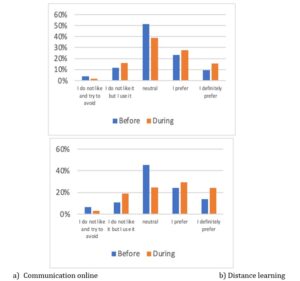
Fig 9. Distribution of respondents in accordance to attitudes towards communication online (a) and distance learning (b)
The individual changes in the attitudes towards communication online and distance learning in terms of the subgroups are summarized in Table 7.
Table 7: Individual changes in attitudes towards communication online and distance learning
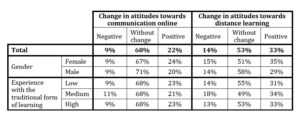
Changes in online activity patterns in relation to other variables
We investigated the relationship between the changes in wellbeing and the changes in attitude towards online communication, and the changes in attitude towards distance learning (see Table 8). It should be noted that 95 percent of respondents who reported an improvement in wellbeing reported a lack of change in attitude towards online communication, or a positive change; the percentage being 97 in regard to attitude towards distance learning. Almost one quarter of respondents with worsened wellbeing reported a negative change in attitude towards distance learning.
Table 8: Relationships between the perceived changes in wellbeing, and the changes in attitude towards online communication and distance learning

For the variables: changes in wellbeing and changes in attitude towards online communication, the chi-square equals 32.6. Since it is greater than the border value of 14.8602, it can be concluded that these variables are dependent with a significance level of 0.005. The C-Pearson contingency coefficient is 0.2, which indicates a weak relationship between the variables. For the variables: changes in wellbeing and changes in attitude towards distance learning, the chi-square equals 67.1. Since it is greater than the border value of 14.8602, it can be concluded that the examined features are dependent with a significance level of 0.005. The C-Pearson contingency coefficient is 0.3, which indicates a weak relationship between the variables (slightly stronger than in the online communication case). The direction of these relationships requires further investigation.
Analysis and Discussion
The research result confirmed that learning activity contributes greatly to the increase in time spent in front of the computer during the pandemic. However, this increase is to a lesser extent among highly experienced respondents. They have probably already spent a considerable number of hours online before the pandemic.
The decline in the number of face-to-face friends was predictable, however the fall in the number of online friends during the pandemic in all subgroups of respondents was unanticipated. That might mean that the need for contacts may drop in general, which is quite surprising. However, we should keep in mind that this conclusion is based on the estimated values, hence it should be taken with caution.
As far as the attitude towards online communication is concerned, the growth in the group “I do not like but use (some people rejected online communication)” is visible, with groups “I prefer” and “I definitely prefer” increased, as people became convinced to communicate online. However, in the group “I definitely prefer”, the increase was lower.
As far as the scale of changes in attitudes towards online learning is concerned, a small positive value means a positive change in attitudes in the entire population, which can also be interpreted as “e-learning is working”. When compared to online communication, the increase is greater, which can be interpreted that more students have acquired a positive attitude towards it, but also that those who did not use it before or have used it sporadically, become accustomed to use it.
It comes as no surprise that the decline in wellbeing translates into an attitude towards online communication and distance learning: the largest group of negative attitude change is for those with worse wellbeing, i.e., more than three times more people indicating a decrease in wellbeing, also indicated a negative change of attitude, when compared to those who indicate a lack of change, or an improvement.
Limitations
The survey was conducted online during a pandemic. It was directed to all students, however those who were more tired of communication online or with worse attitude towards this type of communication might not have taken part in it. That is why the student sample might not be representative of the whole population and results might be biased (less representation of students with worse attitude or tired of activities online). Besides, the respondent population came from only one university in Poland. In future research, we would like to compare the results of our research with similar research conducted in other countries to investigate cultural differences.
Implications
The results of the research might be used to shape the post-pandemic policy of higher education. They have shown that there are different groups of students, with different preferences, and that higher education institutions should try to meet their expectations. Higher education institutions should be flexible in providing an educational offer adjusted to different groups of students. The interrelation between wellbeing and the perception of online communication and distance learning, and social communication preferences, might suggest that the shaping of the educational process is a complex task in which various professionals should be involved, including psychologists and sociologists.
Conclusion
The research goal was to investigate the changes in students’ online behavior caused by the pandemic. We conducted the survey at Cracow University of Economics, Poland. 1005 students shared their experience related to activities online before and during the pandemic. The analysis of data was divided into three steps: (1) students’ wellbeing; (2) changes in online behavior in terms of the number of hours spent online, the number of hours online related to studies, the number of friends face-to-face and online, and the preferable size of group for social activities; (3) relationship between wellbeing and attitude towards online communication and distance learning. The main research results showed that, worryingly, the estimated number of online friends has dropped. Besides, there seem to be some relations between wellbeing and perceived attitude towards online communication and distance learning, however the direction of these relations requires further investigation.
Acknowledgments
The Project has been financed by the Ministry of Science and Higher Education within “Regional Initiative of Excellence” Programme for 2019-2022. Project no.: 021/RID/2018/19. Total financing: 11 897 131.40 PLN.
References
- Afroz, R., Islam, N., Rahman, S. and Anny, N. Z. (2021), ‘Students’ and Teachers’ Attitude Towards Online Classes during Covid-19 Pandemic: A study on three Bangladeshi government colleges,’ Research in Business & Social Science, 10 (3), 2147-4478.
- Conrad, R. C., Hahm, H. C., Koirea, A., Pinder-Amaker, S. and Liu, C. H. (2021), ‘College Student Mental Health Risks during the COVID-19 Pandemic: Implications of Campus Relocation,’ Journal of Psychiatric Research, 136, 117-126.
- Coyle, C., Hanya Ghazi, H. and Georgiou, I. (2020), ‘The Mental Health and Well-being Benefits of Exercise during the COVID-19 Pandemic: a Cross-sectional Study of Medical Students and Newly Qualified Doctors in the UK,’ Irish Journal of Medical Science (1971 -), Springer, 190 (3), 195-196.
- Curry, D. (2021), ‘Microsoft Teams Revenue and Usage Statistics (2021),’ [Online], [Retrieved September 27, 2021], https://www.businessofapps.com/data/microsoft-teams-statistics/ .
- Herbert, C., El Bolock, A. and Abdennadher, S. (2021), ‘How do you Feel during the COVID-19 Pandemic? A Survey using Psychological and Linguistic Self-report Measures, and Machine Learning to Investigate Mental Health, Subjective Experience, Personality, and Behavior During the COVID-19 Pandemic Among University Students,’ BMC Psychology, 9 (90).
- Händel, M., Stephan, M., Gläser-Zikuda, M., Kopp B., Bedenlier, S., and Ziegle, A. (2000), ‘Digital Readiness and its Effects on Higher Education Students’ Socio-emotional Perceptions in the Context of the COVID-19 Pandemic,’ Journal of Research on Technology in Education, 1-13.
- Ismaili, Y. (2021), ‘Evaluation of Students’ Attitude Toward Distance Learning During the pandemic (Covid-19): a Case Study of ELTE University,’ On the Horizon, 29 (1), 17-30.
- Iqbal, M. (2021), ‘Zoom Revenue and Usage Statistics (2021),’ [Online], [Retrieved September 27, 2021], https://www.businessofapps.com/data/zoom-statistics/.
- Keyserlingk, L. von, Yamaguchi-Pedroza, K., Arum, R., and Eccles, J. S. (2022), ‘Stress of University Students Before and after Campus Closure in Response to COVID-19,’ Journal of Community Psychology, 50(1), 285-301.
- Lee, J., Jeong, H. J. and Kim, S. (2021), ‘Stress, Anxiety, and Depression Among Undergraduate Students During the COVID-19 Pandemic and their Use of Mental Health Services,’ Innovative Higher Education, 46, 519–538.
- Lischer, S., Netkey, S., and Dickson, C. (2020), ‘Remote Learning and Students’ Mental Health During the Covid‑19 Pandemic: A Mixed‑method Enquiry,’ Prospects.
- Liu, C., McCabe, M., Dawson, A., Cyrzon, C., Shankar, S., Gerges, N., … and Cornish, K. (2021), ‘Identifying Predictors of University Students’ Wellbeing during the COVID-19 Pandemic – A Data-Driven Approach,’ International Journal of Environmental Research and Public Health, 18 (13), 6730.
- Muthuprasad, T., Aiswarya, S., Aditya K. S., and Jha, G. K. (2021), ‘Students’ Perception and Preference for online Education in India During COVID -19 Pandemic,’ Social Sciences & Humanities Open 3 (1), 100101.
- Rippé, C. B., Weisfeld-Spolter, S., Yurova, Y. and Kemp, A. (2021), ‘Pandemic Pedagogy for the New Normal: Fostering Perceived Control During COVID-19,’ Journal of Marketing Education, 43 (2), 260-276.
- Stewart, W. H. and Lowenthal, P. R. (2021), ‘Distance Education Under duress: a Case Study of Exchange Students’ Experience with Online Learning During the COVID-19 Pandemic in the Republic of Korea,’ Journal of Research on Technology in Education, 1-15.
Annex
Survey items related to the current study
The questionnaire items were developed by Svitlana Didkivska, Dariusz Dymek, Mariusz Grabowski, and Grażyna Paliwoda-Pękosz from the Cracow University of Economics, Poland.
PART 1 – SOME INFORMATION ABOUT YOURSELF
- Gender: male; female; prefer not to say
- Study level: undergraduate; MA studies; doctoral studies
- Form of studies: full time; part time
- Year of study: first; second; third; fourth; fifth or higher
- Age: under 20; 20 – 24; 25 – 30; 31+
- I use information and communication technologies/tools at the level of: beginner; below average; average; above average; professional
- My technical conditions (access to the Internet and equipment: PC, laptop, tablet, smartphone, etc.) I would describe as: I have constant problems; I have frequent problems; Sufficient for basic needs; I have occasional problems; I do not have any problems
PART 2 – BEFORE AND DURING THE PANDEMIC
- The number of hours spent online per week (not counting professional work, but including studies) is approximately (up to 15h; 16 – 25h; 26 – 35h; 36 – 45h; over 45h) Before the pandemic | During the pandemic
- The number of hours per week related to online studies (e.g., attending classes, preparing for classes, looking for materials, writing essays) is approximately (up to 10h; 11 – 20h; 21 – 30h; 31 – 40h; over 40h) Before the pandemic | During the pandemic
- Estimated number of friends* in regular socializing via electronic media (social media, online forums) (up to 5; 6 – 15; 16 – 30; 31 – 50; over 50)* Before the pandemic | During the pandemic
*Friends are people with whom we actively maintain contact in the private sphere, e.g., colleagues from the student group are not friends, as long as we do not keep in touch with them, we do not treat occasional comments on Instagram as contact.
- Estimated number of friends in face-to-face contacts (up to 5; 6 – 15; 16 – 30; 31 – 50; over 50) Before the pandemic | During the pandemic
- The frequency of communicating with friends via electronic media (occasionally; a few times a week; once a day; several times a day; constantly) Before the pandemic | During the pandemic
- What group do you prefer to spend time in (live) (like to be alone; several people; a dozen people; several dozen people; several hundred people) Before the pandemic | During the pandemic
- What is your attitude towards Internet communication? (I don’t like it and try to avoid; I don’t like it but I use it; neutral; I prefer it; I definitely prefer it) Before the pandemic | During the pandemic
- What is your attitude towards distance learning (not only organized forms but also e.g., training videos on YouTube)? (I don’t like and try to avoid; I don’t like it but I use it; neutral; I prefer; I definitely prefer) Before the pandemic | During the pandemic
- How has your mental health changed after switching to distance learning? (significantly deteriorated; worsened; no change; improved; significantly improved)



















